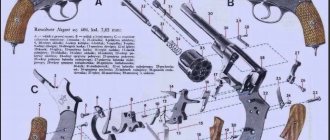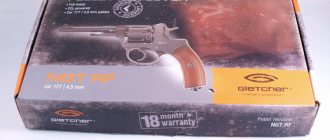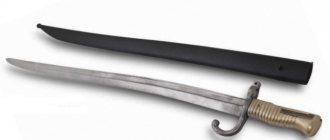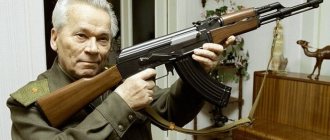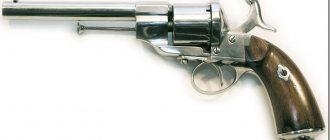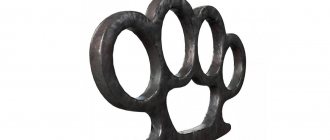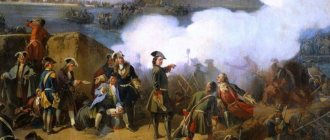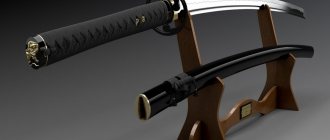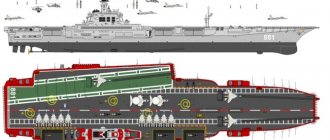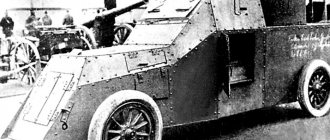Nagant system revolver, Nagant (7.62 mm Nagant revolver model 1895, GRAU Index - 56-N-121) - a revolver developed by Belgian gunsmiths brothers Emile (Émile) (1830-1902) and Leon (Léon) ( 1833-1900) Nagant, which was in service and produced in a number of countries in the late 19th - mid-20th centuries.
The history of the appearance of the Nagant revolver
The Nagan system revolver is a product of the painstaking work of the Belgian gunsmiths brothers Leon and Emil Nagan, which subsequently underwent numerous modifications and can rightfully be called legendary. The initial model developed for the army was the six-shot officer model of 1878, which used 9.4x22 mm ammunition with a self-cocking trigger mechanism.
In 1883, the Nagan brothers introduced a revolver designed to arm junior ranks, called the 9-mm Nagan 1883 revolver. The difference from the “officer” model was in one detail that blocked the self-cocking system, which forced the hammer to be cocked manually before each shot. In 1886, the first modified version of the revolver was presented - changes affected the number of mainsprings, reducing them to one, and adaptation to the then widespread 7.5 mm ammunition with a pyroxylin charge.
Revolver Nagan - video
In the last quarter of the 19th century, many states began to think about rearmament of their armies. By that time, the most promising examples of personal short-barreled firearms were revolvers, which combined sufficient simplicity of design, multiple charges and reliability. The Belgian city of Liege was one of the European centers of the arms industry. Since 1859, there was the Emile and Leon Nagant Arms Factory (Fabrique d'armes Emile et Léon Nagant) - a small family workshop that repaired Dutch revolvers and designed its own firearms. The first revolver of the original design was presented by the elder brother Emil for testing to the Belgian military department, and it was adopted as an officer and non-commissioned officer weapon under the name “revolver model 1878”.
The Model 1878 9mm revolver had a six-shot design and was equipped with a “double action” mechanism, meaning cocking could be done directly by the shooter’s hand or automatically when the trigger was pulled. For non-commissioned officers of the infantry, cavalry and auxiliary personnel, on instructions from the leadership of the Belgian army, the “9-mm Nagant M/1883 revolver” was developed with deliberately degraded combat qualities: due to the introduction of an additional part, the possibility of firing “self-cocking” was excluded, after each shot it was necessary to cock the hammer again. Several more modifications of the revolver were produced in different calibers and barrel lengths. Soon, Emil Nagan almost completely lost his sight as a result of illness, and the main work on improving the design was undertaken by Leon Nagan.
Model 1886
In the 1886 model, the weight of the weapon was slightly reduced and the reliability and manufacturability of the design were significantly improved, for example, the four springs of the trigger mechanism were replaced with just one two-spring one. Also, the new model took into account the existing trend in the development of weapons towards a reduction in caliber; the most common 7.5 mm cartridge with smokeless powder was chosen at that time. One of the main problems facing revolver designers was the breakthrough of powder gases into the gap between the breech end of the barrel and the front end of the drum. In the design of the Belgian gunsmith Henri Pieper, a solution to the problem of obturation was found: before the shot, the trigger mechanism pushed the revolver drum forward, the cartridge had a special design, the bullet in it was completely recessed into the cartridge case, the role of the seal was played by the barrel of the cartridge case, distributed and pressed by the powder gases at the moment of firing bore, which eliminated the possibility of gas breakthrough. This principle, with a significant simplification of the design that pushes the drum onto the barrel, was used by Leon Nagan in 1892; a cartridge with a sleeve equipped with an elongated barrel was developed for the new model of the revolver. This model of the Nagant revolver has become a classic; subsequent modifications did not bring any noticeable changes to the design.
Design of the 1895 Nagant revolver
The 1895 Nagant pistol was based on the 1892 model. But adapting the weapon to the requirements of the Russian army, it was equipped with a drum for seven rounds of 7.62 x 38 mm caliber, traditionally produced in two versions - “officer” with a self-cocking combat mechanism and “soldier”, requiring manual cocking of the hammer.
One of the design features of the weapon is the reloading method. To reload, it was not necessary to remove the drum; for this reason, it was on a spring-loaded axis, and for loading it was necessary to fold back the lid covering the chambers of the drum, which greatly slowed down the reloading process.
To remove the spent cartridges, the lid was also folded back, the cleaning rod was moved to the side, and by inserting it into the cavity of the cartridge case, extraction took place. But this innovation was also a plus - in non-standard situations, cartridges did not fall out of the drum, as, for example, happened in the Gasser revolver of 1870.
One of the key features of the weapon was the solution to the problem of breakthrough of powder gases, which reduced the power of the shot. To do this, they used a cartridge with a bullet recessed into a fairly long sleeve and changed the drum drive, which allowed it to move along its axis. Thus, during the firing process, the drum moved in the direction of the shot, and the sleeve protruding slightly beyond its limits entered the breech of the barrel. By expanding, the cartridge case blocked possible leaks of powder gases, and after the bullet left the barrel, the drum moved back along the axis, simultaneously bringing a new cartridge under the barrel. This principle was called “obturation,” created by the Nagan brothers’ closest competitor, Henri Piper, designer of the Bayard systems.
How the revolver works
The operating principle and design of the weapon does not differ significantly from the rest of its contemporaries, except for the obturation process. To fire a shot, the shooter pulls the trigger, uncocking the hammer. As the trigger moves, the drum moves along its axis and forward, driving the cartridge case into the breech of the barrel. The trigger hits the cartridge primer, igniting the powder mixture, and a shot occurs. The drum then moves back. The next shot repeats the process.
In the “soldier” version, it was necessary to manually cock the weapon before each shot.
Revolver “Nagant” interactive model
Revolver trigger
The trigger mechanism is a classic hammer type. The firing pin is attached to the trigger with a hinged mount. The combat plate is located in the handle. The sear and trigger are combined into one part. There is no safety cock; its role is played by a special part that blocks the interaction of the firing pin and the cartridge without pressing the trigger. When the trigger was pressed, the part was moved to the side, allowing the striker to puncture the capsule.
Cartridge for a revolver
The Nagan revolver cartridge 7.62 x 38 was specially designed for the 1895 model. The ammunition had a narrowed neck of the cartridge case, necessary for sealing in the barrel bore. It was thanks to this design that it became possible to create the BraMit modification.
Ballistic properties
The bullet demonstrated good accuracy for those times - at a distance of 25 meters, about half of the ammunition was placed in a circle with a diameter of 13 centimeters. If the shooter used a stop, then the diameter of the circle was reduced to 7 centimeters.
The penetrating ability of the bullet was also impressive - at a distance of 25 meters it pierced through three boards two and a half centimeters thick, standing at a distance of 8-10 centimeters from each other.
Design
All revolvers of the Nagan design have common fundamentals and features:
- the presence of a double-action trigger mechanism, which made it possible to shoot with both pre-cocking and self-cocking (with the exception of “soldiers’” and “non-commissioned officers” pre-revolutionary models, in which the self-cocking mechanism was blocked in order to reduce ammunition consumption)
— monolithic one-piece frame
- a door that opens the chambers of the drum by turning it to the side. The exception is the 1910, which has a door that swings back to release the drum, which swings to the right.
— the barrel is screwed into the frame with a tight fit
- a ramrod, in the combat position hidden in the axis of the drum, and after firing plays the role of an extractor (ejector) of spent cartridges
— the mechanism located in the frame is closed with a flat lid
The cylinder of a revolver is both a chamber and a magazine. The most common model (model 1895) and most of its modifications have a drum capacity of 7 rounds. The hollow axis of the drum is inserted into the frame from the front and held in it by a ramrod tube installed in front of the drum on the neck of the barrel with the ability to rotate on it as on an axis. On models with a drum pushed onto the barrel, the drum is equipped with a return mechanism consisting of a drum tube and a spring. On the right wall of the frame there is a drum locking device, the role of which is played by a spring-loaded door. In the open (tilted to the side) position, the door allowed the revolver to be loaded and unloaded; when closed, it covered the chamber, preventing the cartridge from falling out and preventing the drum from turning counterclockwise. The drum has seven slots and recesses for the door protrusion in the open and closed positions. The revolver mechanism consists of parts that perform the functions of a locking mechanism, a trigger mechanism and rotate and push the drum onto the barrel: the breech, the slide, the trigger with the pawl and the mainspring. Sights consisted of a rear sight with a sighting slot on the top of the frame and a front sight on the front of the barrel. In total, there are 39 parts in the design of the 1895 model revolver.
Trigger mechanism
The trigger mechanism is hammer-operated, double-action (a version with only a single-action trigger was also produced), the firing pin is hinged on the trigger, the mainspring is plate-type, double-fingered, located in the handle. The sear is integral with the trigger. There is no safety, but when the trigger is not pressed, a special part prevents the firing pin from coming into contact with the primer. When cocking, the hammer also activates a specific locking mechanism that moves the revolver drum forward, and the trigger ensures that the drum is stopped from rotating.
Fighting power
From 35 steps (25 m) on a package of dry pine boards, 2.54 cm (one inch) thick, located at a distance of 8 cm from one another, penetration is observed: 3 boards - 100% bullets, 4 boards - 70%, 5 boards - 25%. One board penetrates at a distance of up to 200 steps (140 m).
Production
Already the early 9-mm model of 1878 received positive reviews from the Belgian army, which contributed to the popularity of the Nagan factory brand on the world market. The 1895 Nagant revolver, as well as its modifications, were produced by many arms companies around the world. Among them: Belgian “Lepage”, “Baillard”, “Frankot”, German “Enel” in Suhl, Russian Imperial Tula Armory, Polish in the city of Radom and others.
Knights of St. George with Nagant 1915
Adoption into service in Russia
At the end of the 19th century, the Russian Empire began massive rearmament of its army. The Mosin rifle of the 1891 model was chosen as the main model of small arms. The standard revolver was a model of the 4.2-line (10.67 mm) Smith-Wesson III revolver of the 1880 model, which was obsolete by that time. The Commission for the development of small-caliber guns, headed by Lieutenant General N. G. Chagin, was involved in the search for promising models. The main requirements for the new army revolver were as follows:
— Great stopping effect of the bullet. Since cavalry was one of the main types of troops, a shot at an effective range (up to 50 steps) should stop a horse.
— “Strength of combat” should ensure the penetration of four to five inch pine boards.
— Small weight (0.82-0.92 kg).
— The caliber, number, direction, profile of the barrel rifling, etc. must coincide with those of the three-line Mosin rifle, then in the manufacture of revolvers it will be possible to use defective rifle barrels.
— The revolver should not be equipped with a self-cocking firing device, because it “harmfully affects accuracy.”
— The initial speed of the bullet must be at least 300 m/s.
— The revolver must have good accuracy of fire.
— The design should be simple and technologically advanced.
— The revolver must be reliable, insensitive to dirt and poor operating conditions, and easy to maintain.
— Extraction of cartridges should not be simultaneous, but one after another.
— Sights must be designed so that the bullet’s flight path intersects the aiming line at a distance of 35 steps.
— Drum capacity is at least 7 rounds.
— Cartridge with flanged brass case, jacketed bullet and smokeless powder.
The officer's revolver is a revolver with a self-cocking firing mechanism.
The rejection of self-cocking firing and simultaneous extraction of spent cartridges was caused by the opinion that, firstly, they would complicate the design (which would negatively affect the reliability and cost of the revolver), and secondly, they would lead to “excessive consumption of ammunition.”
The announced competition and potential gigantic order aroused enormous interest among domestic and foreign arms manufacturers. Several modifications of the existing Smith and Wesson revolver were introduced, including revolvers and automatic pistols. The main struggle took place between the Belgian gunsmiths Henri Pieper with the M1889 Bayard revolver model and Leon Nagan with the M1892.
Leon Nagant had to remake the revolver for the Russian 7.62 mm caliber and, as in 1883, eliminate the possibility of self-cocking shooting, worsening the characteristics of the weapon in accordance with the requirements of the competition. Two options were presented - 6- and 7-round revolvers. Pieper's revolver was rejected due to its large mass and unreliable design. Leon Nagant's victory in the competition was probably largely due to the fact that he already had long-established connections in the Russian military department. For a patent for a revolver, Nagan asked for 75,000 rubles, which he was ultimately denied and a repeat competition was scheduled with new, clarified conditions. In addition to the characteristics, they stipulated a bonus: 20,000 rubles for the design of the revolver and 5,000 for the design of the cartridge; in addition, the winner “gave his invention into the full ownership of the Russian government, which received the right to manufacture it both in his country and abroad, without any additional payment to the inventor.” Pieper submitted to the competition newly redesigned revolvers with original automatics, which the commission considered “ingenious, but not practical.”
Nagant cartridge (right) of the old model - with a cylindrical cartridge case - in comparison with other revolver cartridges of a similar caliber
S.I. Mosin's six-barreled revolver was also rejected. The improvements in the design of the Nagant revolver were less significant, and after comparative tests with the 4.2-line Smith-Wesson revolver, the design was approved. Based on the results of military tests, the officers participating in them expressed an insistent desire to obtain a double-action revolver with the ability to self-cocking. Returning to the self-cocking version of the revolver, the commission did not consider it completely satisfactory, so it was decided to adopt two types of revolvers for service with the Russian army: self-cocking for officers and non-self-cocking for non-commissioned officers and privates. After making a number of minor changes, the design was approved in the spring of 1895.
On May 13, 1895, by decree of Nicholas II, the “soldier” and “officer” models of the Nagan revolver were adopted by the Russian army, but according to the military department, revolvers were officially adopted into service in June 1896, by order of the Minister of War No. 186.
An early release cartridge with a deeply compressed cartridge case.
The purchase price of a revolver produced in Belgium did not exceed 30-32 rubles for the Russian army. The contract provided for the delivery of 20,000 Model 1895 revolvers over the next three years. The Belgian side was also contractually obligated to provide assistance in setting up the production of revolvers at the Imperial Tula Arms Factory. The design of the Russian-made revolver underwent a slight modernization: the back of the handle was made solid (and not split, as in the Belgian version), and the shape of the front sight was simplified. Production technology has also been improved. The cost of the Tula revolver was 22 rubles 60 kopecks. The order for five years - from 1899 to 1904 - amounted to 180,000 units. However, when comparing prices, it should be taken into account that in Russia the revolver was produced at a state-owned enterprise and many costs were not taken into account. For example, to establish production, the treasury purchased machine tools worth more than a million rubles from the USA. If this amount had been paid directly by the Tula plant, the production price would have been much higher.
A cartridge case from a late release cartridge with a bullet compressed at three points and a cartridge from a 7.62×26 sports revolver with a lead bullet.
Operation and combat use
The 1895 Nagant revolver went through a long battle path, ending it in the mid-2000s: the suppression of the Yihetuan uprising, the Russo-Japanese War, two world wars, the October Revolution and the Civil War - this is not a complete list of armed conflicts where the revolver was used in combat. In the mid-nineties, they remained in service only with geological expeditions, but even from there they were withdrawn as an obsolete weapon.
Use in Russia and USSR
The Nagan revolver became the standard weapon of officers of the army of the Russian Empire in 1895. But due to the constant reduction of the military budget, it was possible to equip the army with the necessary amount of weapons only in the second half of 1917.
How the revolver appeared in the Russian army in 1895
At the end of the 19th century, the question of rearmament of soldiers and officers of the Russian army was raised. The officers' personal small arms were Smith & Wesson III 1880 revolvers. The heaviness and inconvenient dimensions, unsatisfactory technical characteristics only hindered its use.
To select the optimal model, the Ministry of War decided to hold a competition for the development of personal weapons. There were only two competitors - the brothers Nagan and Henri Pieper with the Bayard 1889 model. For unknown reasons, the results of the first competition were canceled.
The second competition took place some time later, as a result of which the Nagan brothers won, providing a weapon that fully met the performance characteristics of the commission’s requirements. According to the rules of the competition, the winner had to renounce the right of monopoly production, ensure the transfer of drawings and set up the production of weapons in Russia, and also had obligations to supply the first batch of weapons.
The opinion of the officers who participated in the tests was also important. It was thanks to the opinion of these officers that the decision was made to divide the weapon into an officer's revolver and a soldier's revolver, the difference between which lay in the design of the trigger. The unanimous opinion was that junior ranks of the army should not be trusted with a self-cocking weapon model due to the low level of shooting training, and the model with a double-action trigger was slightly inferior in accuracy due to the heavy trigger, and, accordingly, a sharp jerk when firing.
1900-1917
From the moment it was put into service until the 1917 revolution, the revolver managed to establish itself as an unpretentious and reliable weapon, having passed through several major military conflicts with honor. Also, in 1915, the modernization was finally rejected, which actually turned the revolver into a carbine with a barrel length of 300 mm.
1917-1939
Having become a model of weapon reliability, Nagan continued to serve in the Red Army, but only in the self-cocking version. The only modernization during this period was carried out in 1930, slightly changing the shape of the sighting devices. Around the same years, the tradition took root of considering all revolvers to be the “Nagan” system, which is fundamentally incorrect.
1939-1945
For a number of reasons, weapon production was not stopped after the adoption of the TT semi-automatic pistol. One of them was the possibility of firing from personal weapons through the embrasures of a tank, for which TTs were not suitable, and new weapon models did not pass factory tests.
The process of evacuation of the Tula arms factory to Izhevsk greatly affected the quality of weapons. Most of the qualified specialists were called up to the front in the ranks of the active army. The process of outflow showed itself to be especially strong in the case of Nagan revolvers produced in 1942, when a fairly large percentage of defects was revealed during the production of weapons.
However, in 1945, the production of revolvers was discontinued due to obsolescence. At the same time, the Nagant was finally removed from the army's arsenal. But he remained in service in the ranks of law enforcement agencies and the justice system.
Tactical and technical characteristics of the Nagan system revolver
| Curb weight, kg | 0,88 |
| Total length of weapon, cm | 22 |
| Barrel length, cm | 11,4 |
| Number of barrel rifling | 4 |
| Cartridge | 7.62 x 38 mm |
| Sighting range, m | 25 |
| Drum capacity | 7 rounds |
| Initial bullet speed, m/s | 260 |
| Aim | open, unregulated. |
| Combat rate of fire, rounds/min. | 7 shots in 15-20 seconds |
For shooting from a revolver with the BraMit device installed, it was recommended to use a pointed Nagant cartridge of 7.62 x 38 mm caliber.
Main modifications of Nagant
Nagant 1910 - a modified model, had a drum that tilted to the right to increase reload speed.
Combat
- The Soldier's Nagan is a revolver with a single-type trigger. Out of production in 1918.
- The Commander Nagan is a revolver with a self-cocking trigger; for concealed carry, the barrel was shortened and the handle was reduced. Mainly used by NKVD officers.
- version for sabotage operations, modified by the Mitin brothers. The process of pressing the cartridge case into the breech of the barrel has been improved; it is possible to mount a silent combat device designed by the Mitins. Also for this modification, cartridges with a pointed bullet were developed.
Civil
The emasculated Nagan (abbreviated as SHP), as well as its MMGs, converted from combat copies, but deprived of the ability to fire a shot, are very popular among collectors and weapon lovers. Also, due to its legend, the empty Nagan revolver is often found in films, TV series, etc.
Sports
Based on the Nagan, the following variants of sporting weapons were developed:
- A revolver designed by Smirny in 1926 chambered for a 5.6 mm rimfire cartridge.
- The 1953 Nagant revolver had a weighted barrel and an adjustable sight. Single action trigger
- MTs-4 designed by Paramonov.
- TOZ-36 is a sports revolver designed by Khaidurov.
- TOZ-49 - modernization of Khaidurov’s revolver chambered for 7.62 x 26 mm.
- TOZ-96 is a model chambered for .32 S&W Long Wandcutter.
Sporting and hunting weapons
- KR-22 “Falcon” is a conversion model with a 500 mm long barrel, designed for hunting small animals. Caliber .22LR.
- The Gnome is a sports training pistol chambered for the 4 mm Flaubert cartridge.
Civilian self-defense weapon
Gas and traumatic versions of weapons are produced on the basis of decommissioned combat revolvers:
- Traumatic revolver R-1 “Naganych” chambered for 9 mm RA cartridge;
- Traumatic revolver Nagan VPO-502 and service RS for caliber 10 x 23T;
- Skat-1R;
- Brigade commander;
- Nagan RF;
- RNR UOS;
- Skat-1Rk is sometimes called shortened Nagan;
Also in Ukraine, the production of G-Nagan has been established - a classic version, converted into a gas revolver for self-defense.
Use in Russia and USSR
1900—1917
The first successful combat use of revolvers of the Nagant design dates back to 1900. The Russian expeditionary force took part in pacifying the “Boxer Rebellion” in China. On June 3, 1900, during the capture of the Taku fortification, which blocked the mouth of the Peikho River, the commander of the combined company of the 12th Siberian Regiment, Lieutenant Stankevich, one of the first to break into the enemy’s position, shot and killed two attacking Chinese soldiers.
Reductions in War Department appropriations since 1903 led to a sharp decline in revolver production, and the outbreak of the Russo-Japanese War forced the government to use emergency loans for the purchase of weapons. In 1905, the Tula plant was ordered to produce 64,830 units of the 1895 model revolver, but only 62,917 revolvers were produced. After the war, funding for the army rearmament program was once again reduced, and an interdepartmental commission created in 1908 allowed the production of revolvers according to orders directly from military units.
The tsarist government began preparing for a big war too late: the “Great Program to Strengthen the Army” was announced only on July 7, 1914, three weeks before the start of the First World War. At this time, the armies of developed countries begin to replace revolvers with self-loading pistols, the best examples of which are superior to revolvers in combat characteristics (especially in rate of fire, reloading speed and dimensions). In Russia, another rearmament was considered inappropriate.
By July 20, 1914, according to the report card, the troops had 424,434 Nagant revolvers of all modifications (out of 436,210 required by the state), that is, the army was provided with revolvers by 97.3%, but already in the first battles the losses of weapons were significant. Measures were taken to reconstruct the arms industry, and 474,800 revolvers were produced between 1914 and 1917.
The 1895 model revolver was distinguished by its comparative simplicity of design, manufacturability and low cost. The labor intensity of manufacturing one revolver was about 30 machine hours. At the same time, some assembly operations (installation of the mechanism axes into the frame) required fairly highly qualified personnel. In combat conditions, one of the main advantages was unpretentious operation and reliability: thus, a misfire did not in any way affect the possibility of firing the next shot and did not cause a delay. You can also note the high maintainability of the revolver.
7.62 mm revolver of the Nagant system, model 1895 (soldier's, pre-revolutionary production)
1917—1939
Nagant became one of the symbols of the Russian Revolution of 1917 and the subsequent civil war, and later the word “Nagant” became a common noun - in colloquial speech “Nagant” was often called any revolver, and sometimes a self-loading pistol.
Only the self-cocking (“officer”) version of the revolver was adopted by the Red Army, while the technological documentation was transferred to the metric measurement system in 1918. During the Civil War, the Tula Arms Plant continued to produce revolvers - between 1918 and 1920, 175,115 units were manufactured (52,863 units in 1918, 79,060 units in 1919 and 43,192 units in 1920). After the end of the Civil War, the issue of rearmament of the Red Army was repeatedly raised, but even after the TT pistol was adopted for service in 1930, the production of revolvers continued.
In June-July 1930, the design and production technology of the revolver underwent a slight modification: the sight slot became semicircular instead of triangular, the front sight was supposed to be changed to rectangular, but then a more complex semicircular-truncated shape was introduced. The cost of one Nagan revolver (with a set of spare parts) in 1939 was 85 rubles
The Commander's revolver is a compact version of the revolver.
1939—1945
Until the beginning of World War II, the production of revolvers and pistols at the Tula plant was maintained at approximately the same level; from 1932 to 1941, more than 700,000 revolvers were produced. The advantages of pistols were quite obvious to the leadership of the Red Army, but for a number of reasons the TT pistol and revolvers were produced in parallel. One of the reasons was the opinion that the pistol must be suitable for firing through the embrasures of a tank. The TT pistol was clearly not suitable for this, and new models of pistols that had a barrel that was not covered by a casing turned out to be worse than the TT. In 1941, the Tula Arms Plant was evacuated to Udmurtia, to the city of Izhevsk, where the production of revolvers continued, and in 1942 a partial re-evacuation was carried out from Izhevsk to Tula.
More than 370,000 revolvers were produced between 1942 and 1945. The revolver was in service with the Red Army, the Polish Army, the 1st Czechoslovak Corps, the 1st Romanian Infantry Division named after Tudor Vladimirescu, the 1st Yugoslav Infantry Brigade, and the French Normandy-Niemen fighter regiment.
During wartime, the percentage of defects in production increased, due to the lack of qualified personnel. The finishing quality of military-issue revolvers was lower than in peacetime. The combat use of revolvers revealed the obsolescence of its design and insufficient combat qualities; the most noticeable loss in comparison with self-loading pistols was the low practical rate of fire (that is, a large loss of time for reloading).
After the end of the Great Patriotic War, the revolver was removed from service with the Soviet army and its production was discontinued. However, Nagan system revolvers were in service with the police until the mid-1950s, and in the paramilitary security and collection systems for much longer. At least until 2000, revolvers were used by geological enterprises. According to the regulations of the USSR Ministry of Geology, the heads of parties and expeditions, chief and senior geologists were armed with revolvers.
Combat modifications
soldier's revolver - a revolver with a non-self-cocking firing mechanism, production discontinued in 1918;
officer's revolver - a revolver with a self-cocking trigger mechanism;
carbines - before the First World War, a limited number of carbines with a barrel length of 300 mm and an integral butt and a revolver with a barrel extended to 200 mm and a removable butt were produced for the border troops.
The commander's revolver is a compact version of the revolver, intended for concealed carry, with a barrel length reduced to 85 mm and a shortened handle. Developed in 1927, produced until 1932 in small batches, about 25 thousand pieces were produced. Entered service with OGPU and NKVD officers.
in addition, for reconnaissance and sabotage units in 1929, a revolver with a silencer , equipped with a silent-flameless shooting device “BRAMIT” system of the brothers V. G. and I. G. Mitin.
Nagant wz. 30 - Nagan revolver model 1895, Polish production, from 1930 to 1939 it was mass-produced at the arms factory in Radom, a total of 20 thousand units were produced in Poland. Revolver revolvers in two modifications: Ng wz.30 and Ng wz.32
Carbine with a barrel length of 300 mm and an integral butt
Sports modifications
Nagan-Smirnsky training revolver of the 1926 model - designer A. A. Smirnsky, in 1925-1939. 3500 pieces produced. chambered for a 5.6 mm rimfire cartridge.
sports revolver of the Nagan system - model 1953, had a weighted barrel, non-self-cocking trigger mechanism, adjustable sights
MTs-4 - model of 1955 with a barrel length of 147 mm, designer - V. A. Paramonov. The revolver was produced in 1956-1966, a total of 8220 units were produced. MC-4 and MC-4-1.
TOZ-36 is a sports revolver, model 1962, designed by E. L. Khaidurov.
TOZ-49 is a sports revolver of the 1972 model, designer E. L. Khaidurov. It is distinguished by a shortened drum for a 7.62×26 mm revolving cartridge.
TOZ-96 is an export version of TOZ-49 chambered for .32 S&W Long Wadcutter, produced since 1996.
Conversion into sporting and hunting weapons
The KR-22 “Falcon” carbine is a conversion model chambered for the .22 LR cartridge; it is a revolver with a barrel extended to 500 mm, a wooden fore-end and an integral wooden butt. The weight of the carbine is 2 kg. Production of the carbine began in 2010
The "Grom" revolver is a conversion model produced in Ukraine, a sports and training revolver chambered for the 4-mm Flaubert cartridge
Conversion to civilian self-defense weapons
In the early 2000s, based on the Nagan revolver, several variants of gas and traumatic revolvers were developed, which were produced by converting them from combat “revolvers”.
— in Russia they produce civilian self-defense weapons: traumatic revolvers P1 “Naganych” chambered for 9 mm RA and VPO-502 “Nagan-M” chambered for 10×32 mm T, as well as the service traumatic revolver RS chambered for 10×23 mm T.
— gas and traumatic revolvers “Skat 1R” , “Kombrig” , “G-Nagan” , “Nagan RF” and the shortened “Skat 1Rk”
In accordance with forensic requirements, changes were made to the design of “rubber shooters” to exclude the possibility of firing live ammunition.
Signal (noise) modifications
VPO-503 "Nagan-S" ("Bluff") - a signal revolver for the Zhevelo capsule, produced since the summer of 2006. Manufacturer - Vyatsko-Polyansky carries out alterations of combat revolvers stored in warehouses. The design of the revolver excludes reverse conversion into a military weapon (the chambers of the drum are converted to the caliber of the primer, the barrel is bored out, and a plug is inserted into the breech of the barrel). At the same time, the appearance of the revolver is almost completely preserved. All factory numbers, marks of masters and inspectors are also intact. The revolver is disassembled and serviced in the usual way.
MP-313 (Nagan-07) . In the summer of 2008, the production of revolvers at Molot began to be curtailed and production was transferred to the Izhevsk Arms Plant. In the MP-313, compared to the “Bluff”, changes have been made to the design of the barrel plug (the new plug has a more thoughtful shape), the barrel is bored to a smaller diameter, the serial number of the revolver on the frame has been removed, the frame is not milled at the breech of the barrel, the number drum, and sometimes other parts, does not correspond to the internal number on the frame, the bushings for “Zhevelo” are not pressed into the chambers of the drum, but are screwed into threads pre-cut into them. The revolver comes with a cleaning cloth and a double-sided screwdriver.
R-2 is a signal revolver for the Zhevelo capsule, the next version after the MP-313.
Manufacturer: Izhevsk Machine-Building Plant. Model features:
— a pin is installed into the barrel of the revolver on the right side through the frame, which is also a plug; the insertion point is welded and ground; however, the barrel looks authentic, the rifling is preserved; — the drum is drilled out, standard Zhevelo inserts are installed in it; - unlike MP-313, the drum number and the number on the cover correspond to the number on the frame; — three new-made stamps are applied to the lid (there were more on the first issue); — there are no new stamps on the drum and the back side of the frame

